Hey everyone, welcome back to the SWU Report! Ok, so it’s been a minute since we’ve met, but now’s the time to dig in and get ready for your very own Secrets of Power sealed prerelease!
Now, sealed is a fundamentally different beast than draft. You’re not making pick-by-pick decisions or reading signals from your neighbors. Instead, you’re cracking six boosters, staring at a pile of cards, and figuring out how to assemble something functional from what you’ve been given. This becomes an exercise in working with that you’ve got, not what you want – and we’re here to tell you some things to keep an eye out for if you have them.
I’ve been digging into Secrets of Power since spoiler season started, and I can tell you this much: the set rewards patience. This isn’t Spark of Rebellion’s aggressive battles. The political intrigue theme means games go longer, which means your card quality matters more than raw speed. Conveniently, that also means sealed pools should have time to actually deploy their bombs and build meaningful board states.
Understanding Your Sealed Pool
Before we dive into specific cards (and trust me, we’re going to talk get to that), let’s establish what you’re trying to build here.
You need approximately 30 playable cards from your pool. That breaks down to roughly seven 2-cost units, a handful of 3-4 cost pieces, some finishers in the 5-7 range, and I would argue as many space units as you can get your hands on. The political theme of this set means that is leans in the ground direction, particularly with Spy tokens and so space units appear less frequently than previous sets, so you really can’t skimp on this category. Your Leader and Base selections matter enormously, of course and define which aspects you’re playing and what strategies you can pursue.
The new Official tribal theme runs through this set like a Coruscant traffic lane. Spy tokens carry the Official trait, and there are numerous payoffs for controlling Officials. Now, you’re not going to have the density of Official synergies you’d want for a fully committed tribal deck in sealed, but these interactions still create real value when they come together.
Of course, the other major mechanic here is Disclose. This keyword demands proper aspect distribution in your deck. If you’re running cards with Disclose requirements, you need enough icons of the relevant aspects to reliably meet those conditions. So if you do choose to go this route, don’t for get that not only do you need to pay attention to the individual disclose costs of each card you play, but also the aspect makeup of everything else in the deck in order to try to hit those disclose costs.
Leaders – Your Foundation for Everything Else
Before we even talk about bombs, let’s address the elephant in the room – your Leader choice matters more in sealed than almost any other single decision. Your Leader defines what aspects you can access, which fundamentally determines what cards you can actually play. So, let’s break down the premier options for Secrets of Power sealed.
Jabba the Hutt

By far one of my favorite Leaders in the set, Jabba offers access to Vigilance, which conveniently contains some of the absolute best limited cards in Cantwell Arrestor Cruiser and Bardottan Ornithopter. We’ll talk about those more later, but that aspect access alone makes Jabba premium.
Now, he doesn’t have much attack – we are talking about a crime lord who lets others do his fighting. But he deploys on a reasonable resource 5 turn, which means you’re flipping him mid-game and putting pressure on the board that is tough to remove with that 8 health. Unfortunately you may not be able to pair him with many Grit units like you would in constructed, but even in limited, you should probably be able to pick up a couple extra unit defeats off his ability. That gives you some extra removal options that can sub in if you didn’t open many in your pool as a whole.
Colonel Yularen
Certainly one of the best pieces of evidence that FFG is pushing for aggro Villainy strategies this time around. If you open a pool of decent low-cost units, this is almost Spirit of Rebellion Leia if you squint. Only Yularen is probably better due to his base attack at 4 instead of 3 + Raid 1 and his ability has much less specific restrictions. That 4 attack is genuinely relevant when he’s deploying on turn 5 and immediately representing real pressure.
His ability really lets you gain some action advantage over the course of the game and with the plethora of Spy token generating effects, it should be reasonable for you to have options on the board which have a low enough cost to be chosen for his ability. If you’ve got the pool for it, this is probably the aggro/rush deck of the format.
Dedra Meero
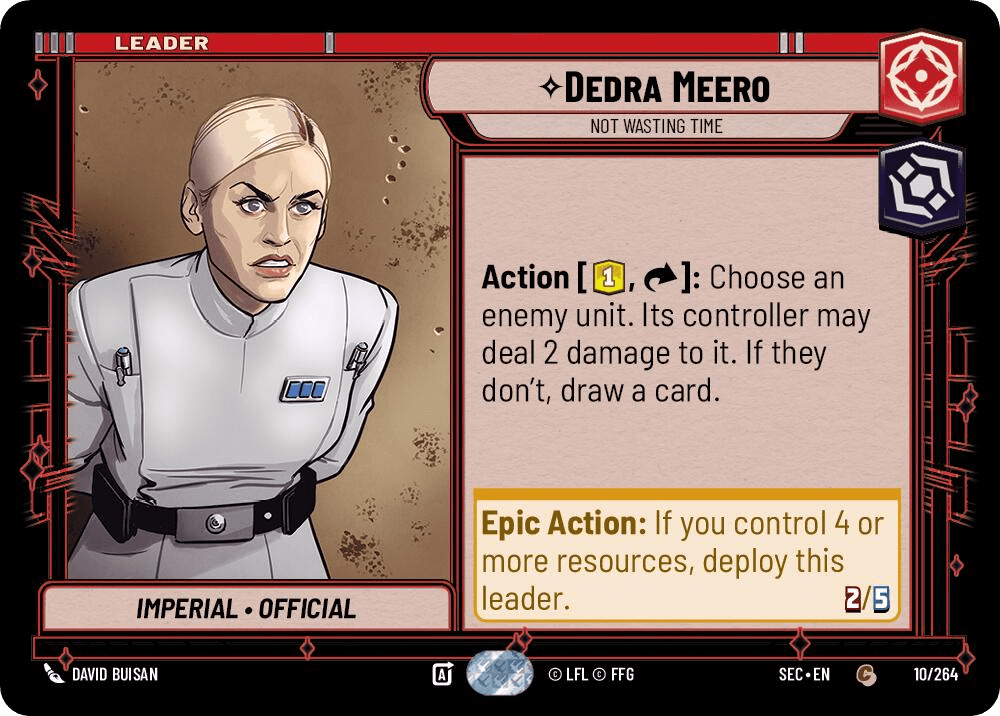
Possibly a very fast Leader for Villainy on its unit side – we’re talking about deploying on turn 4, which is genuinely aggressive for limited. But on the Leader side, she brings an ability that either offers control or card advantage, which is huge for sealed as that is hard to come by.
Her ability lets you spend 1 resource to force an opponent to deal 2 damage to a unit or you draw a card. Sure, your opponent gets to choose which so you’ll usually get the worst of the two options, but at least you do get to choose the character. It’s still nothing to sneeze at. The flexibility here is what matters. You’re either grinding out card advantage or clearing out some units that you might have had to dedicate other resources to. Either way, much like Jabba, she lets you fill in on some key deck aspects that you might be light on with your pool.
Now, the truly astute readers will note that in limited, you’re likely to have turns where you can reasonably spend an odd resource on her ability when you’re off curve anyway. Maybe you deployed a 2-cost unit on turn 3 and have a resource floating. Activate Dedra, force a draw or deal damage, and suddenly that off-curve turn became much more productive. That’s exactly the kind of efficiency that wins sealed games.
Sabé
Here’s a Leader that gets better specifically because of limited’s constraints. In limited and particularly in sealed, your opponent is likely to only have a couple bombs in the whole deck, let alone multiple copies of any given bomb. So, there are very high chances that discarding cards with Sabé gives you the chance to permanently remove obstacles from your opponent’s deck so you never have to face them.
Her ability functions as both information gathering and permanent removal. You see exactly what threats they’re about to draw, identify their bomb, and delete it before they can deploy it. That’s backbreaking in sealed where people’s entire game plans often revolve around deploying 1-2 premium cards. And the fact that you get to look at their hand on her unit side brings even more information gathering to the table in order to know what your opponent is capable of doing.
Luthen Rael
Ok, the Heroic Leaders leave something to be desired for sealed play in this set, which is unfortunate. Sealed tends toward aggressive strategies based on just not generally having enough control cards in a given pool, and Luthen is probably the cream of that crop on the Heroic side. Which isn’t exactly saying much with his 2 attack.
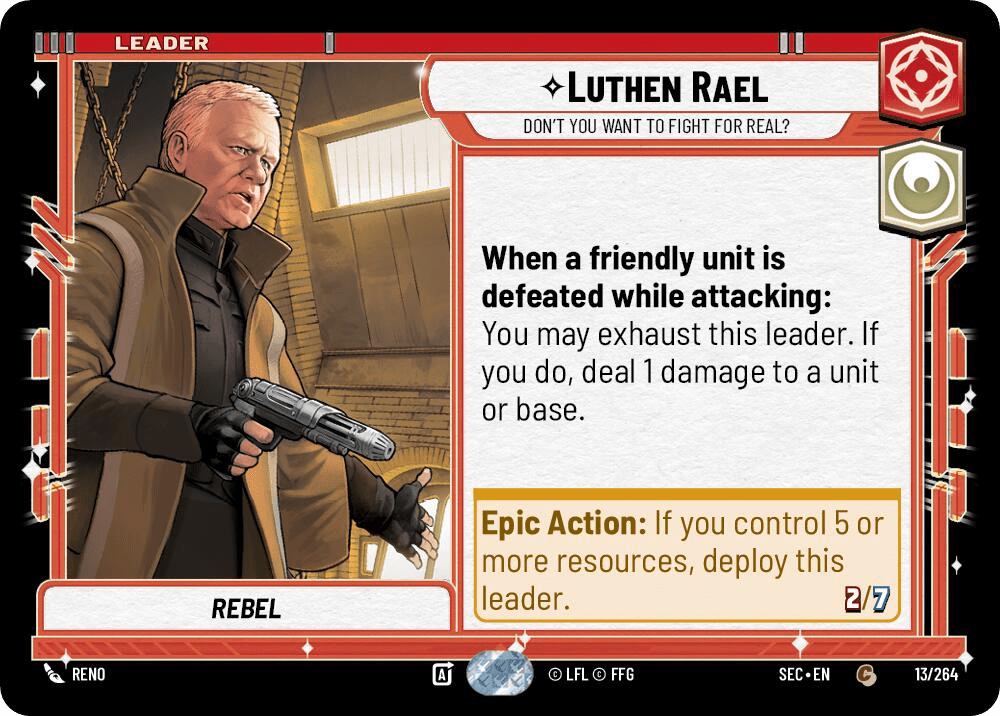
His ability is likely to give you less value in a sealed game than Jabba’s extra removal or Yularen’s tempo generation. But it might provide a bit of closing ability if your opponent has some Sentinels or other defensive positioning.
Really, Luthen’s value comes down to his aspect access. Heroism/Aggression gives you some solid interaction and efficient units. If your pool is heavily concentrated in those aspects, Luthen becomes playable by default. But you’re not excited about it the way you are when opening Jabba or Yularen.
The bottom line on Leaders: Luthen is playable but unexciting. Your Leader choice should be heavily influenced by what bombs and removal you opened. If you have Cantwell Arrestor Cruiser, you’re playing Jabba. If you have premium low-cost Villainy units, you’re considering Yularen. Let your pool guide your Leader selection rather than forcing a Leader that doesn’t match your cards.
The Bombs – Uncommons That Win Games
Let’s start with the haymakers, because sealed formats are often won by whoever opens the best bombs and doesn’t screw up building around them.
Cantwell Arrestor Cruiser (Vigilance/Villainy)

This is the real deal. A 7-cost uncommon that deploys as a 6/7 space unit in a ground focused set? That’s a hydrogen-powered bomb if I’ve ever seen one. The card functions as both a finisher when you’re ahead AND a stabilizer when you’re behind. That’s exactly the kind of dual-purpose utility that wins sealed games.
Now, seven resources is a real investment, but 6 power in space ends games quickly. And 7 HP means this survives combat with almost anything your opponent can throw at it. Plus, it’s when played ability completely locks out your opponent’s biggest threat on the board, giving you time to stabilize or finish as needed – provided you can hit that Disclose cost.
Senator Chuchi, Voice for the Voiceless (Vigilance/Heroism)
Here’s a card that might surprise you with how efficiently it operates. A 3-cost uncommon from Vigilance/Heroism that leverages the Official tribal theme? That’s exactly what sealed decks want – cheap, effective plays that enable synergies.
Now, three resources for an Official unit means this slots perfectly into your curve while activating all those Official-matters cards floating around the set. The aspect pairing of Vigilance/Heroism gives you access to defensive tools and solid unit bases, which matters when you’re trying to survive to deploy your bombs.
The real kicker here is just how much Restore you’re going to be able to generate. With a reasonable amount of paired Officials (like Spy tokens) she should be able to Restore 3 to your side each turn, which is big enough to grind the advancement of most decks to a halt while you buy time to drop a bomb.
Renowned Dignitaries (Command/Heroism)
By far one of the best uncommons in the set for sealed play. This 6-cost 5/6 comes complete with Overhwhelm to make sure that it can keep damage going to the opponent’s base no matter what so you can finish games. But even better, it heals your base on play. The bare minimum of 2 (counting itself) is already reasonable on that body, but as soon as you have another official or two in play? Wowza. Healing for 4 is probably going to be the most common, but 6 is going to happen as well, and that sort of rejuvenation buys you a lot of time.

Cinta Kaz, The Struggle Comes First (Aggression)
Cinta represents exactly the kind of tempo swing that buries opponents in sealed. A 6-cost uncommon from Aggression with the Plot keyword creates explosive deployment turns that opponents struggle to answer.

The Plot keyword means you can deploy this from your resources when you flip your leader, then potentially leverage additional plays in the same action. That’s the kind of compressed value that wins sealed games – you’re not just playing one card, you’re potentially creating multi-card sequences that overwhelm defenses. And as you probably noticed, she brings even more value to the table by enabling an attack from another unit (likely your leader) when you bring her out. That’s effectively three actions worth of tempo wrapped up in one. That’s huge!
Aggression also has access to several other strong aggressive cards, making Cinta a natural focal point for tempo-based sealed strategies. If you’re going Aggression, this is premium value.
Cikatro Vizago (Cunning)
Now this is what I call a value engine. A 3-cost 3/4 that lets you either draw a card or tax your opponent? That great advantage stapled to a reasonable body. Sure, your opponent gets the choice, much like Dedra, but even then you’re hopefully throwing them off tempo. Or better yet, you may be able to wait them out and attack with him after they’re out of resources to ensure you get the draw.
Really, the card draw is what really pushes this over the edge. Drawing cards is always premium in sealed, and Vizago does it while providing a body and resource manipulation. If you’re in Cunning, this absolutely makes your deck.
Valiant Commando (Aggression/Heroism)
Efficient beaters matter in sealed, and Valiant Commando delivers exactly that – sort of. Sure, the 3/3 for 3 resource body doesn’t exactly raise eyebrows, but the ability to defeat it after it deals damage to a base in order to deal an additional 3 to the opponent’s base is some real reach. I wouldn’t suggest doing it on reflex, but there are enough situations that this really helps you close things out that I think this is strongly worth considering – especially if you’re trying to make heroic aggro work out of the rest of your pool.
The Commons That Define Your Deck
Bombs win games, but commons provide the foundation that lets you actually deploy those bombs. Plus, they’re the cards that you’re most likely to actually open in your card pool. Let’s talk about the workhorses of sealed deckbuilding in Secrets of Power.
Bardottan Ornithopter (Vigilance)
Windmill slam pick… wait, wrong format. Windmill slam include in every Vigilance sealed deck you build. This might be one of the best commons in the entire set for sealed play.
A 4-cost space unit from Vigilance with a 3/4 body? That’s solid value already. Space presence is at a premium in this politically-themed set, and getting a space body at common rarity creates exactly the kind of consistent access sealed decks need.
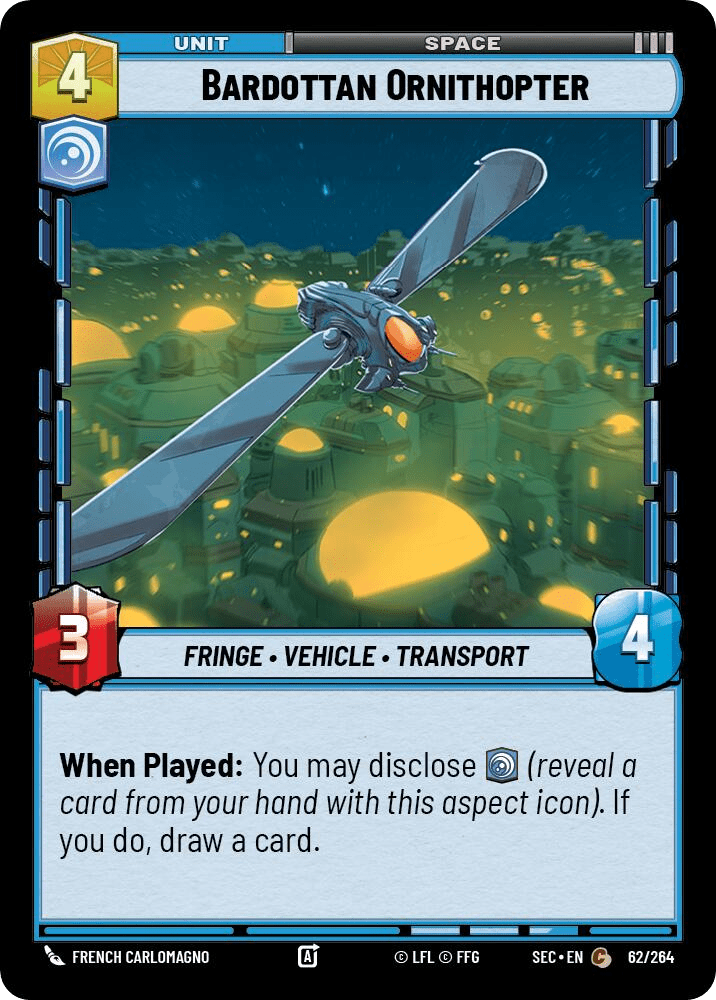
The more important factor here is that it replaces itself on play, creating card advantage! Ok, I know replacement isn’t quite the same, but we’re not here to quibble over that detail. Instead we’re here to revel in this draw in a game that really does very little card effect drawing. Plus, it does so based on the cheapest Disclose cost in the set.
There’s a lot going for the Ornithopter here. If I open one, it’s already making me think about running Vigilance as one of my aspects. If I happen to open two? Game over man, I’m all in on blue.
Dressellian Commandos (Command)
Much like Cintra, this is a card that rewards proper sequencing. A 5-cost 4/5 with Ambush and Plot creates absolutely backbreaking tempo swings when played correctly.
The Plot keyword lets you deploy this from your resources when you flip your leader. That’s already solid, essentially giving you a “free” action to deploy a unit on your turn. But the Ambush keyword is what pushes this into premium territory. You flip, deploy this from resources, and immediately attack with a 4-power threat your opponent wasn’t expecting.
Really, the whole package here is about action economy. You’re compressing multiple game actions into a single moment – leader flip, unit deployment, and attack. It’s maybe a smidge less flexible than Cintra, but only a smidge. This is great value.
Cruel Commandos (Command)
Speaking of efficient beaters, here’s a 5-cost 5/5 common. That’s it. That’s the whole card.

Wait, what do you mean that’s not really the whole card?
Ok, ok, so it also comes complete with Sentinel and Overwhelm. Sure, it’s not a fancy backbreaking ability, but these are two keywords that are workhorses – keeping you alive and helping you push your opponent closer to a loss. It’s not flashy, but this does everything you need it to in limited and does it on a body big enough to be a threat.
GNK Power Droid (Command)
Sometimes a card’s strength lies in its consistency rather than raw power. GNK Power Droid provides exactly that.
The resource acceleration matters more than it might appear. Playing this on turn one means you’re effectively starting turn two with four resources instead of three. That enables 4-cost plays a full turn early, which creates tempo advantages that compound throughout the game. The times this really gets spicy though is when you’re able to power out those game ending threats a turn earlier than expected.
Now, a 1/3 body isn’t winning any fights, but it does block small units and provides a body for various tricks. The real value is the acceleration. In sealed, this kind of fixing is genuinely premium if you’ve got the bombs needed for payoff. Of course, it’s also a Common card, so you’re likely to open multiple copies in sealed. That’s exactly what you want – consistent access to your early-game enablers.
Trade Federation Delegates (Cunning/Villainy)
Here’s your common finisher. A 5-cost 3/4 that deploys two Spy tokens alongside itself creates exactly the kind of board presence that wins sealed games.
The math here gets silly quickly. You’re attacking with 3 power plus two Spy tokens that each have Raid 2 – that’s 7 total damage from a single card. And you’re leaving behind three bodies that your opponent has to deal with individually. In sealed, where removal is expensive and limited, this kind of wide board development can be backbreaking.
The Official trait on both the Delegates and the Spy tokens enables various synergies. But honestly, the primary function is creating overwhelming board presence in the mid-game. If you’re in Villainy, you want every copy you opened.
Outer Rim Constable (Aggression)
Efficient early pressure defines sealed aggro strategies, and Outer Rim Constable delivers. A 2-cost 3/1 provides reasonable attacking stats, even if it’s defeated by anything at all incoming. The key here though is the upgrade removal. I don’t necessarily think there will be a ton of those floating around, but the odds are higher in sealed if your opponent just needed a 28th or 29th card to round things out on aspect. This provides some removal, which as we’ve always said – is at a premium.
Knowledge and Defense (Vigilance)
Event cards in sealed need to be genuinely impactful to justify deck slots over units. Knowledge and Defense absolutely clears that bar.
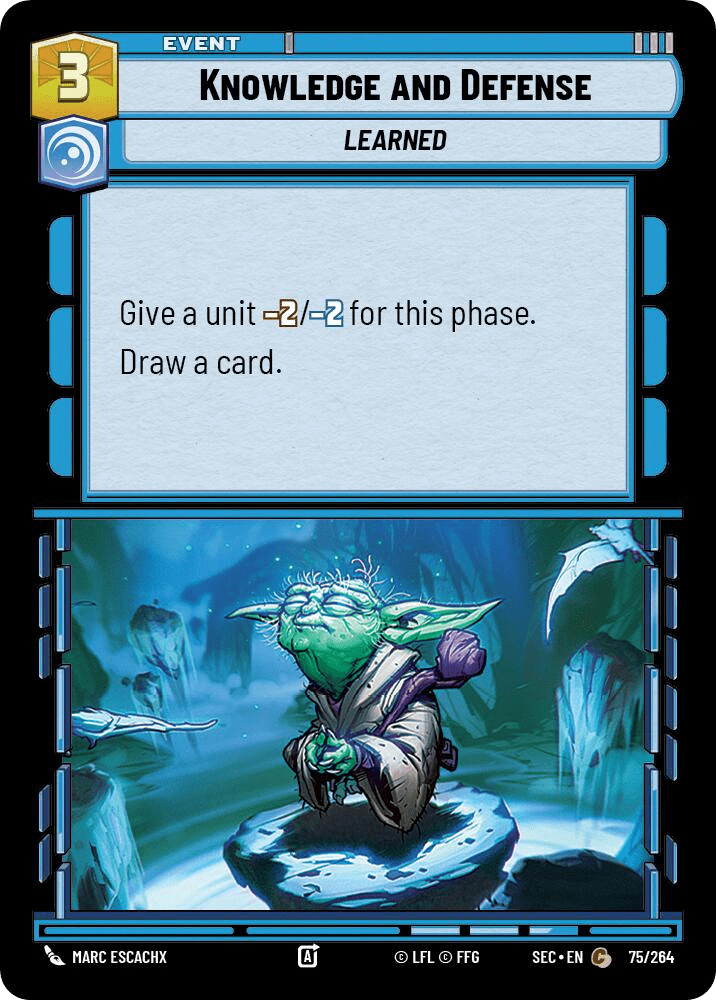
For 3 resource, you give a unit -2/-2 for the phase. The removal options in this set are not the strongest we’ve seen so far, but this is a very reasonable option, especially with 0/2 Spy token floating around, plus you might be able to combine it productively with a Jabba or Dedra trigger to remove something larger than normal.
The real kicker here is the card draw replacement, which is just always going to help you dig to find a copy of something you desperately need and don’t have enough copies of in sealed.
Retaliation (Vigilance)
This is probably going to be the premier removal of this set. Look, there’s not a whole lot to write home about here. You’ve gotta take one on the chin (damage to your base) before you can use this, which hurts and can make the timing awkward and restrictive, but it’s still just about our only option. I saw it play for sure – we just won’t always be happy about it.
Let’s Call it War (Aggression)
Ok, maybe this is in the running for premier removal as well. Sure, much like Knowledge and Defense, it’s going to be most useful against smaller bodies, but the ability to potentially deal damage to two target units if you have initiative does provide some solid options for some action and card advantage if you’re lucky. 3 cost for a possible 5 damage is honestly a pretty good ratio.
Lurking Snub Fighter (Cunning/Villainy)
Plot cards generally underperform in sealed relative to constructed, but some break this rule. Lurking Snub Fighter is one of those exceptions.
A 3-cost 3/3 space unit is already looking like a pretty good investment in this more ground focused set. If your opponent can’t answer that quickly, you could put in some real damage over a couple turns. And of course, the general action advantage of Plot applies here as well. As a bonus here, the Lurking Snub Fighter is cheap enough that you might actually be able to pull of two plot cards on your leader deploy turn if you’re careful.
The kicker here is that When Played exhaust ability, which doesn’t have any targeting restrictions at all. This should help muck up your opponent’s plans one way or another, even if you just played this from hand instead of plotting it.
Kreia’s Whispers (Cunning/Villainy)
Ok, so this one might be a controversial pick, and I do have to hedge me recommendation a bit. What we’ve got here isn’t card advantage, it’s just replacement with a little bit of ability to dig and stack your next draw, but it doesn’t come with a body, which really lowers its ceiling compared to something like the Ornithopter. And it costs 2, which is big enough resource cost to impact your other plays.
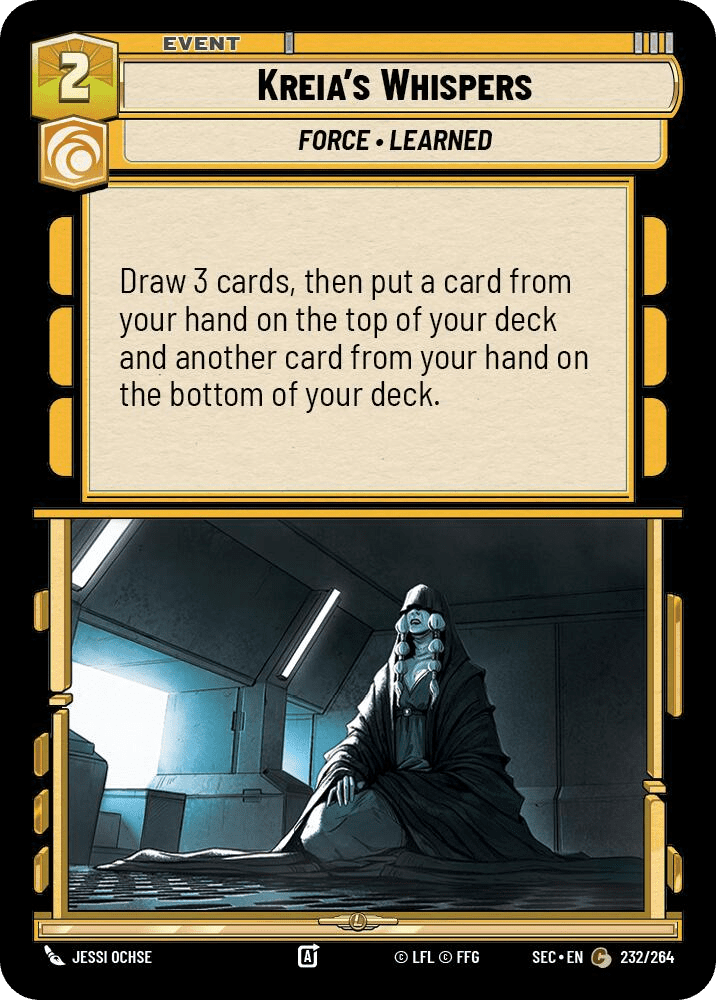
Here’s the thing though, it’s digging 3 cards deep in a 30 card deck. 10% isn’t going to knock anyone over with power, but it’s nothing to sneeze at either. If you’ve managed to open a couple real bombs in your pool, this could be a piece of a deck that is just trying to get their hands on one of those cards as fast as possible. I think this has a home, but it far more dependent on the rest of your deck than most.
Beguile (Cunning/Villainy)
Ok, we already know thanks to Waylay that bounce effects can be pretty worthwhile in SWU and here we have a pretty decent one. Most of the time, I don’t think the 6 or less cost restriction is going to be a huge detriment. There are still a ton of mid range plays that you’ll be more than happy to bounce at the right moment. And this one even comes with the added bonus of getting to look at the rest of the opponent’s hand.
Sure, it’s not truly removal, but it’s a reasonable tempo play or way to clear out a unit with sentinel and the extra knowledge of what your opponent can play next is pretty useful.
Grassroots Resistance (Heroism)
Heroism removal is notably scarce in Secrets of Power, making Grassroots Resistance more valuable than its cost might suggest. For 4 resources, deal 3 damage to a unit and Restore 3. That’s a 6-point life swing from a single card. You remove their threat while gaining life. In sealed, where life totals matter and removal is precious, this kind of dual utility is genuinely premium.
The 4-cost is expensive, yes, and this probably wouldn’t wow us in some other set, but sealed games in Secrets of Power play slowly enough that you’ll find time to play this. And the flexibility of hitting any unit (not just ground or space specifically) means this always has targets.
Contempt for Culture (Villainy)
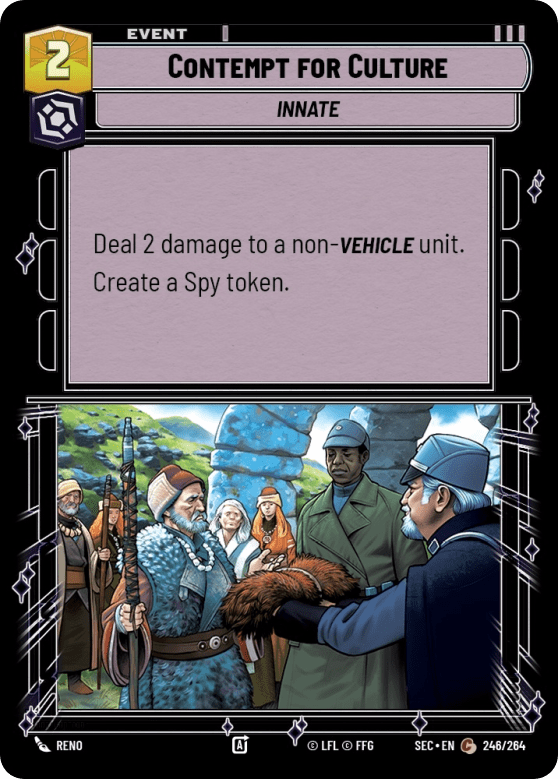
2 damage for 2 resources for any villainy deck is honestly a pretty decent buy in sealed. That’s a reasonable rate of return for a surprise move to finish off a unit or just defeat a Spy straight up. But this also creates a Spy token itself. You get cheap removal and a body all at once. That’s card advantage that can add up. These are the types of things that you want a lot of in order to create that aggregate push that puts you over the top of your opponent over the course of a game where people are often playing suboptimal cards just to get the rest of the deck together.
Building Your Sealed Deck – Practical Guidance
Now that we’ve covered the individual cards, let’s talk about actually assembling your sealed pool into a functional deck.
Start by identifying your bombs and removal. Look at your uncommons/rares first: Are there any Cantwell Arrestor Cruisers or Renowned Dignitaries? Maybe a Grand Admiral Thrawn or Darth Nihilus? We didn’t talk rares in this article since they’ll be so hit or miss in sealed, but those bombs can define what aspects you’re playing. Then look at your removal suite: Retaliation, Contempt for Culture, Beguile, Let’s Call it War, etc. You need interaction to not just lose to opponent bombs.
Check your space unit count next. You absolutely need as many space units as you can manage. Space presence is at a premium in Secrets of Power, and having zero flying defense means you just lose to any opponent with space units. Bardottan Ornithopter is your premium space common, but any space body is better than none.
Evaluate your curve. You need roughly seven 2-cost units to ensure consistent early plays. Junior Senator, Outer Rim Constable, and other efficient 2-drops fit here. Without early plays, you fall too far behind on tempo to recover with your bombs.
Look for synergies but don’t force them. If you opened Senator Chuchu or Trade Federation Delegates, building around Official synergies might make sense. But don’t warp your entire deck trying to maximize fringe synergies. Sealed is about fundamentals: curve, interaction, finishers.
Consider your Leader carefully. Your Leader choice defines what aspects you can play and what strategies you can pursue. Leaders that provide card advantage or resource acceleration are generally strongest in sealed. Avoid Leaders with narrow conditions that require specific card combinations; you might not have those cards.
Final Thoughts
Secrets of Power sealed rewards patience. The political theme creates slower games where card quality matters more than raw aggression. Your bombs win games, but your commons provide the foundation that lets you survive to deploy those bombs.
The Official tribal theme creates real synergies when the pieces come together, but you’re not going to have full tribal density in sealed. Play the synergies you opened, but don’t warp your deck trying to force them.
Space units are at a premium. Don’t skimp on flying defense just because space units are scarce in your pool.
Removal is precious. Include every clean removal spell you opened. Retaliation, Contempt for Culture, Beguile, etc these cards prevent you from losing to opponent bombs. In sealed, interaction matters more than cute synergies.
Good luck at your prerelease events! And remember: sealed is fundamentally about maximizing what you opened, not about perfect deckbuilding. Sometimes you open the nuts, sometimes you don’t. Play tight, understand your role in each matchup, and don’t punt games by missing obvious synergies.
Let me know how your sealed pools treat you in the comments below. Did you open any khyber-powered super (laser) bombs? What synergies came together unexpectedly? I’m always curious to hear how folks’ sealed events actually play out versus theoretical deckbuilding.
Until next time!

